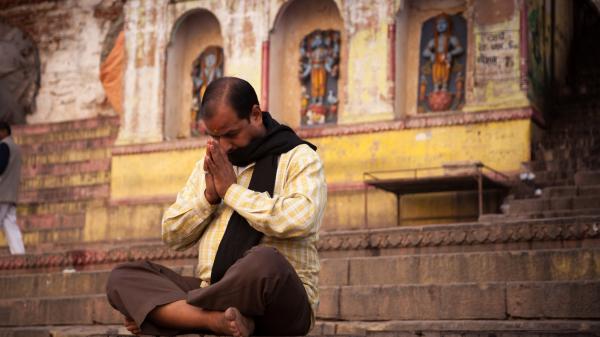Leap Months and Leap Days in the Hindu Calendar
The Hindu calendar offers both lunar and solar time reckoning. To keep the two in sync, months and days are frequently added or omitted.

Man praying in Varanasi, India.
©iStockphoto.com/AAGGraphics
Sun and Moon
The Hindu calendar is a lunisolar time reckoning system, meaning that it attempts to correctly reflect the apparent movements of both the Moon and the Sun over long periods of time.
The calendar's solar strand is primarily based on the length of a tropical year, the time it takes the Earth to revolve around the Sun. Its primary lunar reference is the lunar month, which is the time it takes the Moon to orbit Earth.
Irregular Intervals
The Hindu calendar features two different correction mechanisms: leap months and leap days.
In contrast to the leap day added at nearly regular intervals to the western Gregorian calendar, which always falls on February 29, both leap months and leap days can be added at any point during the year in the Hindu calendar.
Another feature that sets Hindu leap months and leap days apart is the fact that they can not only be added, but they can also be omitted.
The rules used to determine when a month or day is added or omitted are complex and vary from one region to another. The following paragraphs offer a simplified overview of the most important features.
Leap Month Rules
Hindu time reckoning is primarily based on the length of the synodic lunar month, the time it takes the Moon to revolve around the Earth in relation to the Sun. At the same time, it keeps track of solar months, which are defined by the 12 zodiac signs. These are stellar constellations along the apparent path of the Sun during the course of a tropical year. A solar month begins when the Sun moves into a new zodiac sign.
A leap month, commonly referred to as Adhik Maas or Purushottam Maas, is added when a lunar month ends before the Sun has moved to a new zodiac sign. It is omitted when the Sun traverses a whole zodiac sign during the course of a lunar month.
The Hindu calendar year always has 12 or 13 months. If a month is omitted, another month is added elsewhere in the year, so the number of months never drops to 11.
Leap Day Rules
As with months, the Hindu calendar also features both solar and lunar days that need to be kept in sync in the long-run. A lunar day is the time span in which the Moon moves 12° in relation to the Sun. A solar day starts and ends at sunrise.
In some cases, a lunar day may begin just after sunrise and end just before the next sunrise. In that case, a day is omitted in the calendar and the date may jump from the 5th to the 7th. If the opposite happens—a lunar day that includes two sunrises—a day number is repeated in the calendar.